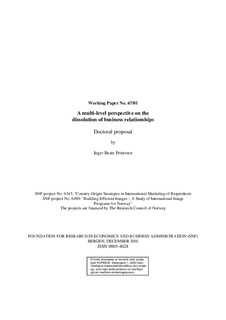A multi-level perspective on the dissolution of business relationships
Working paper

Åpne
Permanent lenke
http://hdl.handle.net/11250/165870Utgivelsesdato
2001-12Metadata
Vis full innførselSamlinger
- Working papers (SNF) [809]
Sammendrag
This report presents a multi-level approach to the dissolution of business relationships. In the literature a number of factors are expected to attenuate the likelihood of relationship dissolution. Structural aspects (such as contracts) have been emphasized by e.g. transaction cost analysis, whereas relational aspects (such as boundary spanner interpersonal bonds) have been highlighted by e.g. relational contract theory. In this study we argue that both macro level phenomena (such as structural ties) and micro level phenomena (such as interpersonal ties) have a potential impact upon relationship dissolution. Moreover, since business relationships are seen as inherently multi-level phenomena, structural and relational aspects would constitute a multi-level issue in these relationships. Besides the argument claiming that factors at multiple levels have an impact upon the likelihood of relationship ending, we also claim that macro-level properties have an impact upon organizational member's behavior. Scholars dealing with interorganizational research have to a large extent left behind the rich stream of organization theory. During the last decade research on organizations have contributed to open up the black box of organizations. Empirical studies have shown that individual's behaviors, affective responses, motives and attitude are affected by structure. A number of organizational dimensions, such as size, formalization and centralization are assumed to influence e.g. decision-making in firms. Accordingly, we argue that a number of organizational and interorganizational dimensions moderate the potential impact of structural and interpersonal ties upon the likelihood of relationship dissolution.
Utgiver
SNFSerie
Working Paper2001:67